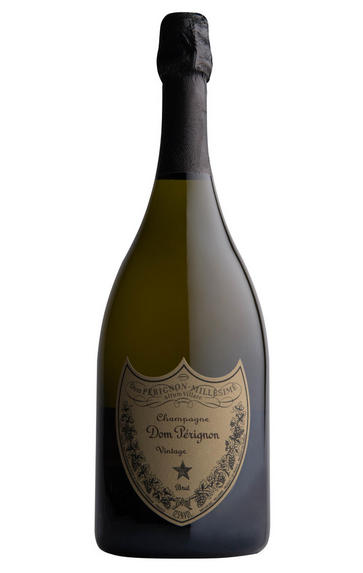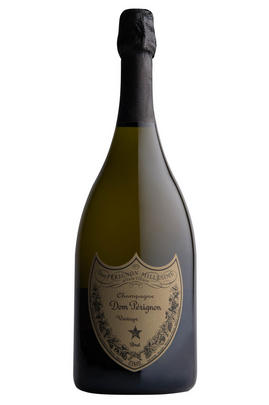
2013 Champagne Dom Pérignon, Brut

Critics reviews
The 2013 Dom Pérignon is quite delicate and understated. It reminds me of the 2004, but with a bit more mid-palate richness and a bit less energy. Apricot, tangerine peel, white flowers, jasmine, mint and light honeyed notes all meld together. There’s lovely vinous intensity as well as a feeling of openness that make the 2013 a delight to taste today. The 2013 doesn’t look to be an epic DP, but it sure is delicious right now.
Drink 2022 - 2038
Antonio Galloni, Vinous.com (November 2022)
Intense, lightly spicy nose and then on the palate very smooth-textured, gentle and lifted, with light bitterness on the finish – grapefruit peel? Some lightly vegetal notes and very long. Seamless texture and already very agreeable.
Drink 2022 - 2032
Jancis Robinson MW, JancisRobinson.com (November 2022)
Disgorged in October 2022, the 2013 Dom Pérignon is a charming and elegant vintage for this cuvée. It reveals complex aromas of buttery pastry, spices, citrus oil, almonds, honey and, with aeration, a touch of smoke. The palate is medium to full-bodied, perfectly balanced, with a chiselled and tightly wound profile. The long, cool growing season has brought freshness and a delicate, earthy note to the finish.
Drink 2023 - 2043
Yohan Castaing.com (April 2023)
Vivid acidity and a chalky underpinning make a crystalline frame for finely detailed notes of ripe melon, mandarin orange, toasted brioche and candied ginger in this harmonious Champagne, which is expressive and expansive on the palate, but with a sense of finesse and restraint. Long and creamy on the mineral-laced finish.
Drink 2022 - 2037
Alison Napjus, Wine Spectator (May 2022)
A driven and serious DP with aromas of chalk, biscuits, apricot stones and lemons. Some spice and dried flowers, too. So sleek and sophisticated. Elegant. Yet, it’s long and powerful, with a sharp minerality. Tight and precise. Reminds me of bottles from the 1980s, such as 1988. It really takes off.
James Suckling, JamesSuckling.com (December 2022)
Disgorged in October last year, the 2013 Dom Pérignon is a lovely wine, defined by the long, cool growing season. Offering up aromas of crisp stone fruit, tangerine oil, buttered toast, pear, almonds and clear honey, it's medium to full-bodied, ample and seamless, with bright acids and a pillowy, enveloping profile, concluding with a long, saline finish. Vincent Chaperon recalls that shatter at fruit set moderated yields and that a drying east wind in the weeks before harvest helped to maintain the good sanitation necessary to wait to pick at full maturity.
Drink 2023 - 2043
William Kelley, RobertParker.com (May 2022)
51% Pinot Noir, and 49% Chardonnay.
Silky, narrowly sculpted and serene, Dom Pérignon 2013 is a less hedonistic release than the 2012 (and less intensely energetic than the 2008) but showcases a beautiful mid-place between tension and expressiveness already. Orange-coloured fruit – apricots, mango and orange – play along with snappy lemon syrup and delicate red fruits, the palate teased into considerable detail and length with some trademark Dom Pérignon smokiness. There is immediate pleasure here, although cellaring will let some of the inner complexity unfurl, revealing this among the finest Dom Pérignon releases of recent times.
Drink 2026 - 2045
Tom Hewson, Decanter.com (June 2023)
About this WINE

Dom Perignon
Dom Pérignon was the 17th century Benedictine monk who has gone down in history as the person who "invented" Champagne. His name was originally registered by Eugène Mercier. He sold the brand name to Moët & Chandon, which used it as the name for its prestige cuvée, which was first released in 1937.
A rigorous selection process in both the vineyard and winery ensures that only the best grapes go into Dom Pérignon champagne. Chardonnay and Pinot Noir are used in roughly equal proportions without one variety dominating the other.
In its youth, Dom Pérignon shows incredibly smooth, creamy fruit with perfect balance and weight. As it ages, it takes on wonderfully toasty aromas and a finesse equalled by very few of the other Grandes Marques.
Since 2014 Dom Pérignon has no longer been using the term oenothèque for its late-release Champagnes, but the word Plenitude. This style represents Dom Pérignon champagne that is left in contact with its lees and does not evolve in a linear fashion, but ages in a series of stages, producing “windows of opportunity, or plenitudes” when the Champagne can be disgorged and released to bring consumers a different expression of the same vintage.
There are three plenitudes in the life of a given vintage: the first plenitude spans between seven to eight years after the vintage, which is when Dom Pérignon Vintage is released, while the second one arrives between 12 and 15 years – which was previously the first oenothèque release, but from now will be branded as P2. The third window comes after around 30 years, when the Champagne has spent more than 20 years on its lees, which will now be termed as P3.

Brut Champagne
Brut denotes a dry style of Champagne (less than 15 grams per litre). Most Champagne is non-vintage, produced from a blend from different years. The non-vintage blend is always based predominately on wines made from the current harvest, enriched with aged wines (their proportion and age varies by brand) from earlier harvests, which impart an additional level of complexity to the end wine. Champagnes from a single vintage are labelled with the year reference and with the description Millésimé.
Non-vintage Champagnes can improve with short-term ageing (typically two to three years), while vintages can develop over much longer periods (five to 30 years). The most exquisite and often top-priced expression of a house’s style is referred to as Prestige Cuvée. Famous examples include Louis Roederer's Cristal, Moët & Chandon's Dom Pérignon, and Pol Roger's Cuvée Sir Winston Churchill.
Recommended Producers : Krug, Billecart Salmon, Pol Roger, Bollinger, Salon, Gosset, Pierre Péters, Ruinart

Champagne blend
Which grapes are included in the blend, and their proportion, is one of the key factors determining the style of most Champagnes. Three grapes are used - Pinot Noir, Chardonnay and Pinot Meunier.
26% of vineyards in Champagne are planted with Chardonnay and it performs best on the Côtes des Blancs and on the chalk slopes south of Epernay. It is relatively simple to grow, although it buds early and thus is susceptible to spring frosts. It produces lighter, fresher wines than those from Burgundy and gives finesse, fruit and elegance to the final blend. It is the sole grape in Blancs de Blancs, which are some of the richest long-lived Champagnes produced.
Pinot Noir accounts for nearly 40% of the plantings in Champagne and lies at the heart of most blends - it gives Champagne its body, structure, strength and grip. It is planted across Champagne and particularly so in the southern Aube district.
The final component is Pinot Meunier and this constitutes nearly 35% of the plantings. Its durability and resistance to spring frosts make the Marne Valley, a notorious frost pocket, its natural home. It ripens well in poor years and produces a soft, fruity style of wine that is ideal for blending with the more assertive flavours of Pinot Noir. Producers allege that Pinot Meunier lacks ageing potential, but this does not deter Krug from including around 15% of it in their final blends.


Buying options
Add to wishlist
Description
51% Pinot Noir, and 49% Chardonnay.
Silky, narrowly sculpted and serene, Dom Pérignon 2013 is a less hedonistic release than the 2012 (and less intensely energetic than the 2008) but showcases a beautiful mid-place between tension and expressiveness already. Orange-coloured fruit – apricots, mango and orange – play along with snappy lemon syrup and delicate red fruits, the palate teased into considerable detail and length with some trademark Dom Pérignon smokiness. There is immediate pleasure here, although cellaring will let some of the inner complexity unfurl, revealing this among the finest Dom Pérignon releases of recent times.
Drink 2026 - 2045
Tom Hewson, Decanter.com (June 2023)
wine at a glance
Delivery and quality guarantee